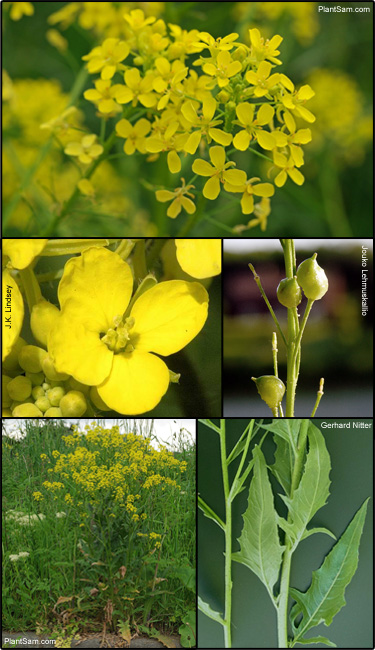Turkish rocket (Bunias orientalis)
 Common Names: Hill mustard, Turkish warty-cabbage
Common Names: Hill mustard, Turkish warty-cabbageDescription:
Habit: Perennial or biennial semi-rosette plant reaching a height of 1.6-2.9 feet.
Leaves: Lower leaves have large, three-cornered edges or sharp-edged, pinnate with 1-2 pairs of lateral leaflets and a large, clefted terminal leaflet, sometimes entire; upper leaves are entire to pinnatifid.
Stems: Erect, 10-45 in. tall and branched in the upper region as flowering begins. Covered in tubercules (warty bumps) and somewhat hairy.
Flowers: 4-8 mm. long, very fragrant, yellow in color, entire or truncate.
Fruit and seeds: 5-10 mm. long, asymmetrically ovoid, 2-4 seeds, covered with small, irregular protuberances.
Habitat: Native to southern Europe and Russia. Can be found in fields, roadsides, dry grasslands and meadows, railways, and floodplain meadows.
Reproduction: By seed.
Similar species: Yellow gardenrocket but can be distinguished by its leaf shape, stem texture, height and fruits.
Monitoring and rapid response: Control should be done in late autumn or before seeds mature. Mechanical/manual control requires two cuttings during the summer. Credits: The information provided in this factsheet was gathered from NOBANIS: European Network on Invasive Alien Species and the University of Wisconsin-Extension.
Individual species images that appear with a number in a black box are courtesy of the Bugwood.org network (http://www.invasive.org). Individual photo author credits may not be included due to the small display size of the images and subsequent difficulty of reading the provided text. All other images appear courtesy of Google (http://images.google.com).
Common Name: | Turkish rocket |
Scientific Name: | Bunias orientalis |
Family: | Brassicaceae (Mustard) |
Duration: | Perennial |
Habit: | Herbs |
USDA Symbol: | BUOR |
